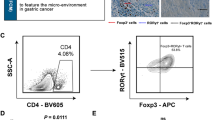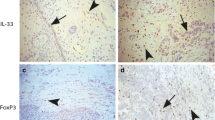Abstract
Purpose and experimental design
Although an increase in regulatory T cells (Tregs) is observed in tumor microenvironments, the underlying mechanism is not fully clarified. Since it was suggested that Tregs showed a lower sensitivity toward oxidative stress in comparison with conventional T cells, in the present study, we investigated the H2O2 production and apoptosis of Tregs in gastric and esophageal cancer tissues, employing flow cytometric analysis using fresh samples (n = 93) and immunohistochemical analysis (n = 203).
Results
The increased tumor-infiltrating Tregs coexisted with elevated H2O2 production according to disease progression. The grade of apoptosis in Tregs was less pronounced than that in conventional T cells, and there was a positive correlation between H2O2 production and the grade of apoptosis in conventional T cells, while there was no correlation between H2O2 production and the grade of apoptosis in Tregs. Moreover, Tregs were less sensitive to H2O2-induced apoptosis compared with conventional T cells in vitro.
Conclusions
We have demonstrated that the increased prevalence of tumor-infiltrating Tregs closely related to their lower sensitivity to H2O2-induced apoptosis.






Similar content being viewed by others
References
Sakaguchi S, Ono M, Setoguchi R, Yagi H, Hori S, Fehervari Z et al (2006) Foxp3+CD25+CD4+ natural regulatory T cells in dominant self-tolerance and autoimmune disease. Immunol Rev 212:8–27
Beyer M, Schultze JL (2006) Regulatory T cells in cancer. Blood 108:804–811
Ichihara F, Kono K, Takahashi A, Kawaida H, Sugai H, Fujii H (2003) Increased populations of regulatory T cells in peripheral blood and tumor-infiltrating lymphocytes in patients with gastric and esophageal cancers. Clin Cancer Res 9:4404–4408
Siddiqui SA, Frigola X, Bonne-Annee S, Mercader M, Kuntz SM, Krambeck AE et al (2007) Tumor-infiltrating Foxp3−CD4+CD25+ T cells predict poor survival in renal cell carcinoma. Clin Cancer Res 13:2075–2081
Curiel TJ, Coukos G, Zou L, Alvarez X, Cheng P, Mottram P et al (2004) Specific recruitment of regulatory T cells in ovarian carcinoma fosters immune privilege and predicts reduced survival. Nat Med 10:942–949
Kono K, Kawaida H, Takahashi A, Sugai H, Mimura K, Miyagawa N et al (2006) CD4(+)CD25high regulatory T cells increase with tumor stage in patients with gastric and esophageal cancers. Cancer Immunol Immunother 55:1064–1071
Mizukami Y, Kono K, Kawaguchi Y, Akaike H, Kamimura K, Sugai H et al (2008) CCL17 and CCL22 chemokines within tumor microenvironment are related to accumulation of Foxp3+ regulatory T cells in gastric cancer. Int J Cancer 122:2286–2293
Maruyama T, Kono K, Izawa S, Mizukami Y, Kawaguchi Y, Mimura K et al (2010) CCL17 and CCL22 chemokines within tumor microenvironment are related to infiltration of regulatory T cells in esophageal squamous cell carcinoma. Dis Esophagus 23:422–429
Niedbala W, Cai B, Liu H, Pitman N, Chang L, Liew FY (2007) Nitric oxide induces CD4+CD25+Foxp3− regulatory T cells from CD4+CD25 T cells via p53, IL-2, and OX40. Proc Natl Acad Sci USA 104:15478–15483
Bergmann C, Strauss L, Zeidler R, Lang S, Whiteside TL (2007) Expansion of human T regulatory type 1 cells in the microenvironment of cyclooxygenase 2 overexpressing head and neck squamous cell carcinoma. Cancer Res 67:8865–8873
Mougiakakos D, Johansson CC, Kiessling R (2009) Naturally occurring regulatory T cells show reduced sensitivity toward oxidative stress-induced cell death. Blood 113:3542–3545
Szatrowski TP, Nathan CF (1991) Production of large amounts of hydrogen peroxide by human tumor cells. Cancer Res 51:794–798
Kusmartsev S, Nefedova Y, Yoder D, Gabrilovich DI (2004) Antigen-specific inhibition of CD8+ T cell response by immature myeloid cells in cancer is mediated by reactive oxygen species. J Immunol 172:989–999
Kondo S, Toyokuni S, Iwasa Y, Tanaka T, Onodera H, Hiai H et al (1999) Persistent oxidative stress in human colorectal carcinoma, but not in adenoma. Free Radic Biol Med 27:401–410
Mizukami Y, Kono K, Kawaguchi Y, Akaike H, Kamimura K, Sugai H et al (2008) Localisation pattern of Foxp3+ regulatory T cells is associated with clinical behaviour in gastric cancer. Br J Cancer 98:148–153
Takahashi A, Kono K, Ichihara F, Sugai H, Amemiya H, Iizuka H et al (2003) Macrophages in tumor-draining lymph node with different characteristics induce T-cell apoptosis in patients with advanced stage-gastric cancer. Int J Cancer 104:393–399
Izawa S, Kono K, Mimura K, Kawaguchi Y, Watanabe M, Maruyama T et al (2011) H2O2 production within tumor microenvironment inversely correlated with infiltration of CD56(dim) NK cells in gastric and esophageal cancer: possible mechanisms of NK cell dysfunction. Cancer Immunol Immunother 60:1801–1810
Suzuki H, Onishi H, Wada J, Yamasaki A, Tanaka H, Nakano K et al (2010) VEGFR2 is selectively expressed by FOXP3high CD4+ Treg. Eur J Immunol 40:197–203
Schmielau J, Finn OJ (2001) Activated granulocytes and granulocyte-derived hydrogen peroxide are the underlying mechanism of suppression of t-cell function in advanced cancer patients. Cancer Res 61:4756–4760
Malmberg KJ, Arulampalam V, Ichihara F, Petersson M, Seki K, Andersson T et al (2001) Inhibition of activated/memory (CD45RO(+)) T cells by oxidative stress associated with block of NF-kappaB activation. J Immunol 167:2595–2601
Klemke CD, Brenner D, Weiss EM, Schmidt M, Leverkus M, Gulow K et al (2009) Lack of T-cell receptor-induced signaling is crucial for CD95 ligand up-regulation and protects cutaneous T-cell lymphoma cells from activation-induced cell death. Cancer Res 69:4175–4183
Lu B, Finn OJ (2008) T-cell death and cancer immune tolerance. Cell Death Differ 15:70–79
Takahashi A, Hanson MG, Norell HR, Havelka AM, Kono K, Malmberg KJ et al (2005) Preferential cell death of CD8+ effector memory (CCR7−CD45RA−) T cells by hydrogen peroxide-induced oxidative stress. J Immunol 174:6080–6087
Mougiakakos D, Johansson CC, Jitschin R, Bottcher M, Kiessling R (2011) Increased thioredoxin-1 production in human naturally occurring regulatory T cells confers enhanced tolerance to oxidative stress. Blood 117:857–861
Cosentino M, Fietta AM, Ferrari M, Rasini E, Bombelli R, Carcano E et al (2007) Human CD4+CD25+ regulatory T cells selectively express tyrosine hydroxylase and contain endogenous catecholamines subserving an autocrine/paracrine inhibitory functional loop. Blood 109:632–642
Acknowledgments
This work was supported by a grant from the Ministry of Education, Culture, Sports, Science, and Technology of Japan.
Conflict of interest
There is no conflict of interest in the present study.
Author information
Authors and Affiliations
Corresponding author
Rights and permissions
About this article
Cite this article
Izawa, S., Mimura, K., Watanabe, M. et al. Increased prevalence of tumor-infiltrating regulatory T cells is closely related to their lower sensitivity to H2O2-induced apoptosis in gastric and esophageal cancer. Cancer Immunol Immunother 62, 161–170 (2013). https://doi.org/10.1007/s00262-012-1327-0
Received:
Accepted:
Published:
Issue Date:
DOI: https://doi.org/10.1007/s00262-012-1327-0




